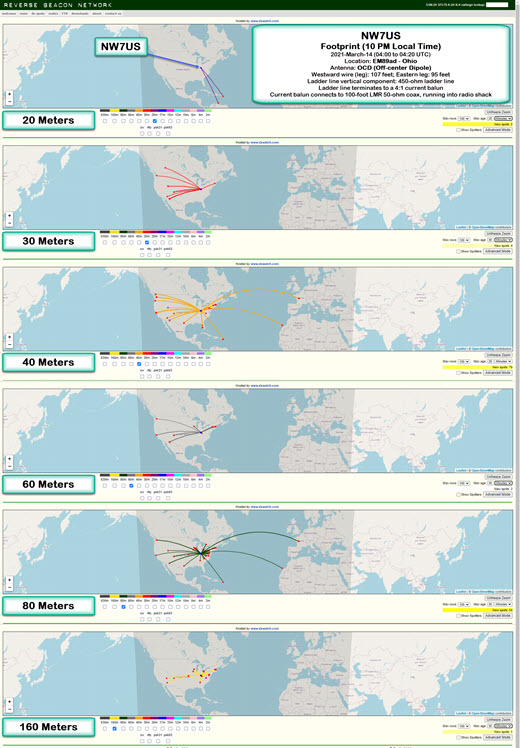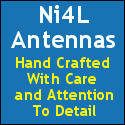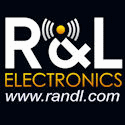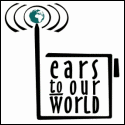Archive for the ‘antenna’ Category
 Unexpected Surprise: What Are The Odds? ATNO DXCC
Unexpected Surprise: What Are The Odds? ATNO DXCC
I have a story for you. All of it is true, but I have not changed my name.
Wow! I am always amazed at those moments in my amateur radio hobby when spontaneous joy is had by unexpected events.
On Thursday, 14-April-2022, at about 17:30 Universal Time (UT), the unexpected occurred, and it started by accident.
I have been reorganizing my radio shack. Once I moved my main transceiver (the Icom IC-7610) from one desk to another, and had it back in operation, I left it tuned to a random frequency, in the CW mode. It was just sitting there, hissing away with the typical shortwave sounds of a frequency on which no one was transmitting. And me? I was going about reorganizing my radio shack.
After a while, I heard the start of a Morse-code CW signal; the operator was sending a CQ call–a transmission that invites a response from anyone who wishes to have a QSO with the calling station. What I heard was, “CQ CQ DE EP2ABS EP2ABS…”
NOTE: This transceiver, my Icom IC-7610, is listening with the new antenna—the 254-foot doublet up at 80 feet–that was raised up into the air here at my QTH by a fine crew from Hams in the Air.
I looked up EP2ABS on QRZ dot com, because I did not know from what country/entity the EP2 prefix on callsigns belongs. I was excited to see that EP2 is from Iran!
I started answering his CQ call, “DE NW7US NW7US,” for at least ten minutes; each time he sent his CQ, I answered. Finally, I heard him answering me, “NW7US NW7US DE EP2ABS 5NN…”
I answered back, sending my signal report, “5NN 5NN DE NW7US TU”
Soon after that simple exchange, he confirmed our QSO by posting our QSO to Logbook of the World (LotW).
Thus, by accident–as I had simply left the transceiver tuned to a randomly-selected frequency and stayed on that frequency listening while doing my chores–I heard the Iranian station calling CQ. What are the odds!?!?
This is my first QSO with Iran, another All Time New One (ATNO). How cool!
Note: This is a testimony to the work from the crew that did the fine work of getting this antenna installed. Here is a video presented by Hams on the Air:
73 de NW7US dit dit
 New Antenna: The Following Footprints Are of My CW Signals (2021-March-14 @ 04:00 to 04:20 UTC).
New Antenna: The Following Footprints Are of My CW Signals (2021-March-14 @ 04:00 to 04:20 UTC).
The following footprints are of my CW signals on 2021-March-14 at about 04:00 to 04:20 UTC.
Click on this image to see a larger version of this image:

Location: EM89ad – Ohio
Antenna: OCD (Off-center Dipole)
Description of Antenna:
This is an off-center dipole, with the two legs running East-East-South (approximately 125 degrees of North), and West-West-North (about 306 degrees on the compass). The westward wire (leg) is approximately 107 feet in length, while the eastward leg is about 95 feet in length.
These legs (an off-center-fed dipole) is directly connected to about 90 feet of 450-ohm ladder line, which is hanging directly below, vertically, the feed point. The feed point is 50 feet above the ground.
The ladder line terminates (at the 12-feet-above-ground point) to a 4:1 current balun. This current balun then connects to a 100-foot LMR 50-ohm coax, which is running into the radio shack. It is connected via an antenna switch to my Icom IC-7610 transceiver. I am transmitting a 100-watt CW signal using an Icom IC-7610, in the following format:
TEST TEST TEST DE NW7US NW7US NW7US
The Reverse Beacon Network reports any spotting of this test transmission. The beta mapping interface, at http://beta.reversebeacon.net/main.php, then maps the resulting spots. To learn more about the RBN, visit http://beta.reversebeacon.net/index.php, or, http://reversebeacon.net/index.php.
I show the 20-, 30-, 40-, 60-, 80-, and 160-Meter band footprints.
I’ve been capturing these CW transmission spots, at different times of the day, today. I’ll get data from several days, at regular intervals, and create a overview of how the antenna appears to be working during this month and under these propagation conditions.
73 de NW7US dit dit
..
 Just Get On The Air! (A Makeshift Temporary Dipole Shortwave Antenna)
Just Get On The Air! (A Makeshift Temporary Dipole Shortwave Antenna)
It might not take as much antenna as you may think would be necessary to make two-way contacts on shortwave radio (as an amateur radio operator putting an HF transceiver on the air). However, often, makeshift antennae are effective enough to be viable–just look at all the contacts many amateur radio operators make with their low-power (QRP) rigs (transceivers) using short, helically-wound, mobile antenna sticks. If they can work magic with such inefficient antenna setups, surely your effort at an antenna would pay off to some degree. Right?
Of course, I want to make a proper dipole out of this example antenna. But, while I wait for the rest of the parts I need to complete this antenna project (pulleys and a ladder, and maybe a potato launcher), I’ve put this makeshift antenna on the air, with it just high enough so that I can enjoy some time on the shortwave bands.
With this antenna, I’ve made successful two-way voice and Morse code contacts (QSOs) with stations in Europe and across North America. I am able to tune it on the 60-, 40-, 30-, 20-, 15-, 17-, 12-, and 10-Meter bands. Reverse beacon detection picks up my Morse-code CW signals, especially on 40 meters (the band on which it is tuned physically).
The bottom line: just get something up in the air and start communicating. Improve things over time. You’ll have much fun that way.
73 de NW7US dit dit
 Software-Defined Radio: Try Before You Buy? You Might Like It!
Software-Defined Radio: Try Before You Buy? You Might Like It!
Sure! You don’t need to have a software-defined radio (SDR) before you start learning how to use the technology; there are a few different paths you can take, exploring and learning about SDR.
One way to gain some experience with SDR without spending a dime is to install a free software package for the very popular, non-Linux, operating system (that starts with ‘W’), and give SDR a test drive. If you like it, you might consider getting your own hardware (like the SDRplay RSPdx, for instance), and connecting it up to your computer and running this software, too.
Why I Dived Into SDR
I have always loved radio, ever since the early 1970s, when I discovered shortwave radio. In the last couple of years, I’ve had an increasing interest in the world of SDR. When I am working, but away from home (remember those days, before Covid?), I want to sample news and programming from around the world, but through shortwave. The way to do that, I found, is by using the various SDR options which allow a person to tune a remote receiver, and listen.
I also find working with the waterfall of a typical SDR-software user interface rewarding because, instead of blindly searching for signals in a subband, I can see all of the received signals on the scrolling time representation of a slice of frequency. Simply select that signal on the waterfall, and the radio tunes right to it.
I often connect to different SDR radios around the world, to catch all manner of shortwave signals, from maritime, military air, trans-oceanic air, or coast guard radio traffic, or other interesting HF communications including amateur radio CW and SSB signals. Occasionally, I also check out VHF and UHF signals from around the world. All of that, while instead an office building that is not suited for shortwave radio reception.
I’ve now decided to give back to the community; I’ve added my SDR receiver to the collection of receivers located around the world on the SDRSpace network of SDR radios.
My new SDRplay RSPdx software-defined radio receiver is live, via http://www.sdrspace.com/Version-3, using the SDR Console software (Version 3).
The receivers are online whenever I am not transmitting and when there are no local thunderstorms.
Antenna Port A is connected to a wire antenna (a horizontal 100-foot wire that runs out from my house’s chimney to a tall tree; about 10 feet of that wire is oriented vertically, where the wire passes through a pulley and then is weighted down so it can move with wind-driven tree movement), while Antenna Port B is connected up to a VHF/UHF discone.
Both antenna systems have an AM Broadcast band notch (reject) filter reducing local AM Broadcast-Band radio station signals by about 30 to 40 dB. I need to use these because the very close KLIN transmitting tower is just miles away and those signals overwhelm the receiver. When I use the signal filters, the local AM Broadcasting signals no longer overwhelm the receiver.
In the following video, I first explain my SDR setup, and in the second half of the video, I tune around the radio spectrum, using the software to control my SDR receiver.
A Couple of Questions
After watching this video, WO9B wrote an email to me. Michael asked of me two questions, summed up as:
1. Your SDR window has the IF screen on top. How is that accomplished?
2. Your AM Broadcast filters; more info, please. I live in the area of mucho broadcast stations and that looks like something I could use.
In the following video, I demonstrate how I changed my layout of the SDR Console software. And, I mention the AM Broadcast Filter for SDR Receivers (the hardware filter is found here: https://g.nw7us.us/3kU5SJN).
To Use My Receiver
Download the latest version of SDR-Console from https://www.sdr-radio.com/download – there is a 32-bit and a 64-bit Windows installation package.
The 64-bit installation package may be downloaded from one of these three sources:
1. Google: https://g.nw7us.us/3auBq44
2. DropBox: https://g.nw7us.us/310ooIG
3. Microsoft: https://1drv.ms/u/s!AovWaZDu7Hrd3U-yqK1bs3wuaFw2?e=o4nKeh
The 32-bit installation package can be downloaded from one of these three sources:
1. Google: https://g.nw7us.us/3iLasrZ
2. DropBox: https://g.nw7us.us/3g4VcVc
3. Microsoft: https://1drv.ms/u/s!AovWaZDu7Hrd3U4mJiiRtI9lm70s?e=HDG4ZX
Install the SDR Console package according to the directions given. Once you have the software installed, you will want to add my server. It takes some work to get familiar with the software, but there are online FAQs on how to begin.
One guide on how to add a server to the list from which you can pick may be found, here:
https://www.sdrplay.com/wp-content/uploads/2018/02/SDRConsoleV3-ServerGuide1-1.pdf
I worked on getting all of the bugs worked out of my installation before making the video. It did take some work, and reading up on things. But, the software is solid and a good contender against SDRuno, and HDSDR, and, this way I can share it online with you.
My server is known as, ‘0 NW7US‘ — it will be online when I am not using my antenna systems for transmitting. It will be offline during thunderstorms, or during times when I must use the systems for transmitting.

Software-defined radio is a great way to hear all sorts of communications, from local AM broadcast stations, FM stations, VHF Air Traffic, to shortwave radio stations including amateur radio HF communications.
Thank you for watching, commenting, and most of all, for subscribing; please subscribe to my YouTube Channel: https://YouTube.com/NW7US Also, please click on the bell, to enable alerts so that when I post a new video, you will be notified. By subscribing, you will be kept in the loop for new videos and more.
73 de NW7US
.. (yes, this is an expansion of an earlier post… forgive the redundancy… thank you) ..
 Check Out My New SDRplay RSPdx Software-Defined Radio Receiver – Live!
Check Out My New SDRplay RSPdx Software-Defined Radio Receiver – Live!
My new SDRplay RSPdx software-defined radio receiver is live, via http://www.sdrspace.com/Version-3, using the SDR Console software (Version 3).
The receivers are online whenever I am not transmitting and when there are no local thunderstorms.
Antenna Port A is a wire antenna (100′), while Antenna Port B is a VHF/UHF discone. Both have an AM Broadcast band reject filter, reducing local AM Broadcast signals by about 30 to 40 dB. I need to use these because the very close KLIN transmitting tower is just miles away and those signals overwhelm the receiver. When I use the signal filters, the local AM Broadcasting signals no longer overwhelm the receiver.
Let me know what you think. Enjoy!
To use my receiver:
Install the latest version of SDR-Console which can be downloaded from https://www.sdr-radio.com/download
Install SDR Console according to the directions given. Once you have the software installed, you will want to add my server.
It takes a little to get familiar with the software, but there are online FAQs on how to begin.
My server is known as, ‘0 NW7US‘ — it will be online when I am not using my antenna systems for transmitting. It will be offline during thunderstorms, or during times when I must use the systems for transmitting.
Software-defined radio is a great way to hear all sorts of communications, from local AM broadcast stations, FM stations, VHF Air Traffic, to shortwave radio stations including amateur radio HF communications.
Thank you for watching, commenting, and most of all, for subscribing; please subscribe to my YouTube Channel: https://YouTube.com/NW7US Also, please click on the bell, to enable alerts so that when I post a new video, you will be notified. By subscribing, you will be kept in the loop for new videos and more.
Video:
73!
 W3EDP Antenna
W3EDP Antenna
My QTH isn’t great for antennas. I’ve tried a few types but haven’t managed to find one that works for me, especially on the lower bands like 40m and 80m. About 2 years ago I made up a W3EDP antenna using some left over wire and a 4:1 balun. It was noisy and worse than anything else I had kicking about. So back in the box it went.
I thought I’d give it another go as domestic planning permission has been relaxed a bit. There are a few different configurations of the antenna but they follow a similar path. A long, not particularly resonant, antenna made up of a long element and a counterpoise.

In my case I followed the ‘ladder line method‘ where the antenna and counterpoise are as a single piece of ladder line for 17ft and the remainder antenna wire is just normal wire. So it looks like the original Zepp antennas and a little bit like this

The diagram above gives an additional component to the ‘normal’ W3EDP antenna. that is an additional counterpoise. I thought I’d give this a go based on a bit of background reading I did. NC4FB explains his experiences with the normal design and I have to say I had similar experiences. Namely that the swr was quite high and it was not that easy to get it down to usable levels on any of the bands when the antenna was first played with. A good idea to try my own extra’s.
So, test gear is as follows.
Antenna connected to homemade 4:1 balun with some mini 8 coax (about 7m) hanging outside a downstairs window. Antenna raised in a V shape with the balun box at ground level and the antenna supported about 1/3 of the way down on an aluminum mast approximately 8m off the ground. The end of the antenna is resting on the fence at about 1.8m off the ground. Hardly ideal but good for enough for a lash up.
I used a MR100 Antenna analyser. These are cheap and good for indicative measurements. There is also some good free software available to use with you Linux PC (There are probably windows varieties but I didn’t look).
I did 4 tests. Vanilla, i.e. no extra counterpoise. A 32ft counterpoise, A 16ft counterpoise & lastly an 8ft counterpoise. The outputs are below.




So what does this tell us?
Actually that there is a good argument on the face of it to add in an additional counterpoise. The 32ft one has a greater effect on the lower bands and the short on the higher bands. Nothing too contentious here then. So what happens if you connect them all up together.

It does lower the swr but that is probably not the only effect. I think this might need some extra experimentation or at least a bit more digging to see how to improve the antenna for my qth. But for now I’ll sort the lash up out and give it some on air testing.
 Indication versus measurement
Indication versus measurement
The nature of a technical hobby gives way to the ‘buying of stuff’. Sometimes this is the tool required to carry out the crux of the hobby, in our case I’m referring to the transceiver. Sometimes this is the tool required to check that the main tool is working correctly, in our case this could any number of tools such as an antenna analyser.
There are also many hams that like to buy the box, or series of boxes and do the minimal amount of testing to ensure safe operation and there are those that will only operate what they have built themselves. Most of us fit on that spectrum. I certainly do, it just varies on what I’m doing.
For longer than I care to admit I have used an antenna analyser that belongs to my local club. It is free to be loaned but I’ve used it more than my fair share of times. I also like to build the odd antenna. This means I measure the length and then cut the wire and check it’s various characteristics and generally cut it again until I’m happy that I have a suitable compromise. Its a really useful tool. I assume its quite accurate because it cost a lot. But do I really need it?
Separating needs from wants is not that easy, partly because what starts out as a want can quite easily become a need. I made a decision recently, I was going to buy my own analyser. But which one? Que the usual looking through specs and performance criteria, guess what happened next. I started with a small requirement for a HF analyser and ended up looking long and hard at analyser >£300. Reflecting on this it becomes easy to bump up the needs because I never really noted down what I actually wanted.
hard at analyser >£300. Reflecting on this it becomes easy to bump up the needs because I never really noted down what I actually wanted.
So what did I actually need? In this case I wanted to ensure that I wasn’t going to damage a transceiver and transmit spurious rubbish (as opposed to my usual cw rubbish). So I didn’t really need a tool to measure, I needed a tool to indicate. But ah ha, I still needed to cut the antenna to the right length, so I did need something to measure but did it need to be really accurate?
It turns out it didn’t. It’ll be a good idea to get a rough idea but to 3 decimal places? nope, it just isn’t that important. So I duly purchased a cheapo SARK analyser off ebay for around £30 and it’s allowed me to measure and get the right length(s) (I built a multiband end fed antenna this time) and use a cheapo end fed tuner and the analyser to get the correct swr and impedance for safe and fairly optimised operation.
The lesson learned is that if I don’t set out the requirements first then I’m going to end up spending 10 times on a product that I probably don’t need.












